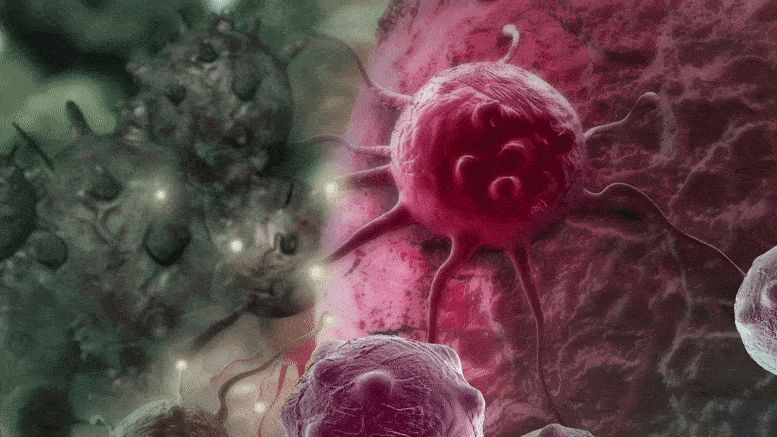

ஆய்வு ஆசிரியர்கள் ஒரு நாள் புதிய செல்லுலார் சிகிச்சைகளை உருவாக்க தங்கள் கண்டுபிடிப்பைப் பயன்படுத்த நம்புகிறார்கள்.
மனித உடலில் உள்ள செயல்முறைகள் பாதிப்பில்லாத நோயெதிர்ப்பு செல்களை இரக்கமற்ற கொலையாளிகளாக மாற்றுகின்றன
சமீபத்திய ஆய்வின்படி, மனித உடலுக்கு பொதுவாக பாதிப்பில்லாத நோயெதிர்ப்பு உயிரணுக் கூட்டங்களை இரக்கமற்ற கொலையாளிகளாக மாற்றும் திறன் உள்ளது, அவை கட்டி செல்கள் மற்றும் வைரஸ்கள் அல்லது ஒட்டுண்ணிகளைக் கொண்டிருக்கும் பிற செல்களைத் தாக்கும்.
காமா டெல்டா டி செல்கள் மற்ற முரட்டு செல்களை அடையாளம் காணவும் அகற்றவும் “முன்-திட்டமிடப்பட்டவை” என்று முன்னர் நம்பப்பட்டது, ஆனால் இப்போது சில வகையான செல்கள் வழக்கமான டி செல்களின் நன்கு அறியப்பட்ட “தகவமைப்பு” துணைக்குழுக்களுடன் பொதுவானவை என்று தெரிகிறது.
செல் அறிக்கைகளில் சமீபத்திய வெளியீட்டில், பர்மிங்காம் பல்கலைக்கழகத்தின் தலைமையிலான இங்கிலாந்து, ஆஸ்திரேலியா, சீனா, நெதர்லாந்து மற்றும் அமெரிக்காவைச் சேர்ந்த சர்வதேச விஞ்ஞானிகள் குழு, வழக்கமான தகவமைப்பு “கொலையாளி” T செல்களுக்கு இணையானவற்றைக் குறிப்பிட்டது.
மூத்த இணை ஆசிரியர் பேராசிரியர் பென் வில்காக்ஸ்[{” attribute=””>University of Birmingham, commented: “Human gamma delta T cells have typically been assumed to be pre-programmed, however, our study shows that at least in blood, some types mirror the behavior of conventional T cells – suggesting they can be ‘trained’ to become extremely potent killers once they recognize aberrant target cells – including those infected with viruses, parasites, or possibly tumor cells.
“Our discovery has implications for efforts to develop gamma delta T cells as novel cellular therapies. We hope that it will change the way scientists think about these cells and how they might contribute to the treatment of cancer and infectious disease.”
Funded substantially by a Wellcome Trust Investigator Award, the group examined the profile of gene expression in human gamma delta T cells – showing the cells in a much more ‘adaptive’ light.
Gamma delta cells exist alongside alpha beta T cells and B cells in vertebrates. Researchers have discovered that select human gamma delta T cells appear to transform their pattern of gene expression to activate a ‘killer’ program – dependent on their exposure to abnormal target cells, with successful recognition of such targets likely a key factor triggering this transformation and subsequent attack.
An extremely strong similarity to conventional adaptive killer T cells suggests that the unique contribution of gamma delta T cells is not the type of response they ultimately mount – such as killing a target cell – but that they are able to recognize abnormal target cells in a very different way.
This suggests that they can mount unconventional adaptive responses in situations when conventional adaptive T cells cannot:
Lead author Jack McMurray, from the University of Birmingham, commented: “There are a number of scenarios in which gamma delta T cells may be uniquely suited to respond, due to their unconventional recognition capabilities. These include particular microbial, parasitic, and viral infections, and potentially some cancers.
“Our research provides a basis for ongoing studies to understand how such unconventional adaptive gamma delta T cell responses are triggered, and also for efforts to harness such responses to develop new and more effective treatments for infections and cancer.”
Reference: “Transcriptional profiling of human Vδ1 T cells reveals a pathogen-driven adaptive differentiation program” by Jack L. McMurray, Anouk von Borstel, Taher E. Taher, Eleni Syrimi, Graham S. Taylor, Maria Sharif, Jamie Rossjohn, Ester B.M. Remmerswaal, Frederike J. Bemelman, Felipe A. Vieira Braga, Xi Chen, Sarah A. Teichmann, Fiyaz Mohammed, Andrea A. Berry, Kirsten E. Lyke, Kim C. Williamson, Michael J.T. Stubbington, Martin S. Davey and Carrie R. Willcox, 24 May 2022, Cell Reports.
DOI: 10.1016/j.celrep.2022.110858